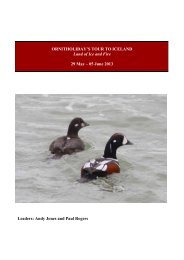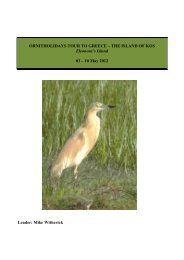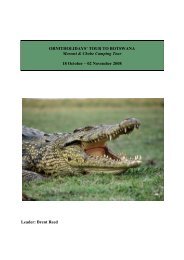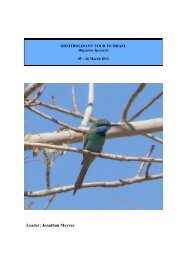Download 2014 Brochure (.pdf) - Ornitholidays
Download 2014 Brochure (.pdf) - Ornitholidays
Download 2014 Brochure (.pdf) - Ornitholidays
Create successful ePaper yourself
Turn your PDF publications into a flip-book with our unique Google optimized e-Paper software.
U S A – F LO R I D A<br />
USA – Florida<br />
Winter Birding in the Sunshine State<br />
Wednesday 14 January – Tuesday 27 January 2015<br />
Principal Leader: Richard Coomber<br />
2015 Cost: £3,399 single room supplement £400<br />
lorida in late January will provide some excellent birding for the start of the year, in a climate that will help the winter at<br />
F home pass rather more quickly. There is far more to this part of the United States than the concrete high-rise blocks of<br />
Miami, as this tour will show. We start at the famous Everglades National Park, before working our way north to the Gulf Coast<br />
and the delights of Sanibel Island, before crossing the state to end up at Merritt Island Wildlife Refuge on the state’s Atlantic<br />
FLORIDA<br />
Fort Myers<br />
Naples Park<br />
Orlando<br />
Titusville<br />
Everglades<br />
coast, where thousands of wildfowl winter. The tameness of the birds ensures excellent viewing and makes this an ideal tour for those<br />
visiting the New World for the first time and provides photographers with many opportunities for wildlife portraiture. We can expect to find a wealth of<br />
egrets, herons, wildfowl, waders and wintering warblers. Richard will be giving some workshops on shorebird identification, as well as helping you<br />
get to grips with American warblers and sparrows! This will be <strong>Ornitholidays</strong>’ 10th tour to Florida at this time of year.<br />
Sebring<br />
Miami<br />
Florida<br />
City<br />
ITINERARY<br />
Days 1 to 3<br />
We leave London on a flight to Miami and transfer<br />
to Florida City, where we stay for the next three<br />
nights. We have three whole days to explore the<br />
southern part of the Everglades National Park,<br />
which will provide us with some excellent birding<br />
and photographic opportunities. At Royal Park<br />
Hammock, the Anhinga Trail leads us past various<br />
herons and egrets (including the white form of<br />
Great Blue Heron), and with luck we might find a<br />
confiding American Bittern or see Purple Gallinule<br />
at close range. American Alligators bask on the<br />
sides of the water channels and a number of<br />
turtles will be hauled out on the dead tree trunks<br />
in the water. The Anhingas, after which the trail is<br />
appropriately named, are a conspicuous feature<br />
and will probably be well into their breeding<br />
season. Amongst the swamps are ‘hammocks’ -<br />
ridges of slightly higher and therefore drier ground<br />
where large deciduous trees, including West<br />
Indian species such as Gumbo Limbo, grow. Here<br />
we might find a number of passerines and<br />
perhaps Barred Owl. Passing through the<br />
Everglades, looking for Short-tailed Hawk, we<br />
notice habitat changes as we approach the coast.<br />
Sawgrass and Dwarf Cypresses give way to<br />
mangroves and tidal flats, on which a variety of<br />
shorebirds feed and Black Skimmers roost at low<br />
tide and where Ospreys are often fishing.<br />
Days 4 & 5<br />
Today we drive round the northern side of the<br />
national park to reach our hotel near Naples Park<br />
on the Gulf coast where we stay for two nights,<br />
with birding en route in the Big Cypress Preserve<br />
area. Species we shall be looking for include<br />
Snail Kite and Limpkin.<br />
The following day Corkscrew Swamp Sanctuary<br />
is our main birding area. We explore the National<br />
Audubon Society Reserve from the boardwalk,<br />
which meanders for two miles through lofty<br />
stands of Cypress trees and where, if we are<br />
lucky, we could see a Barred Owl or two.<br />
Limpkin, Green Heron and Yellow-bellied<br />
Sapsucker may also be seen as well as a<br />
number of passerines, including Tufted<br />
Titmouse, Carolina Wren, White-eyed Vireo,<br />
Black-and-white Warbler and the very colourful<br />
Painted Bunting.<br />
Days 6 to 8<br />
We transfer to Fort Myers, for the next three<br />
nights. During our stay we will spend some time<br />
birding around J. N. “Ding” Darling Wildlife<br />
Refuge, one of the best-known birding sites in<br />
Anhinga<br />
18<br />
For a previous tour report or further information please call: 01794 519445








